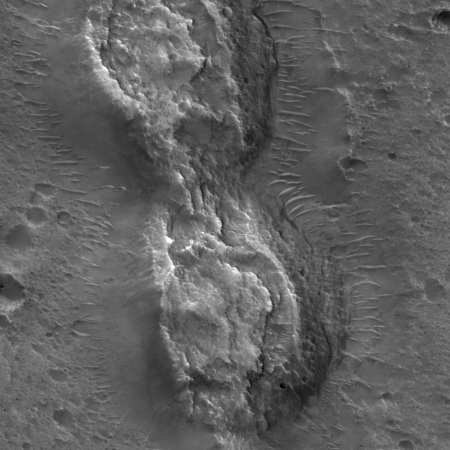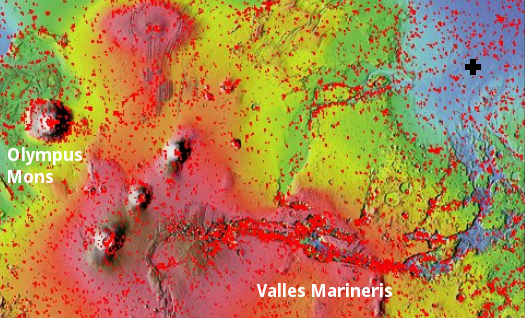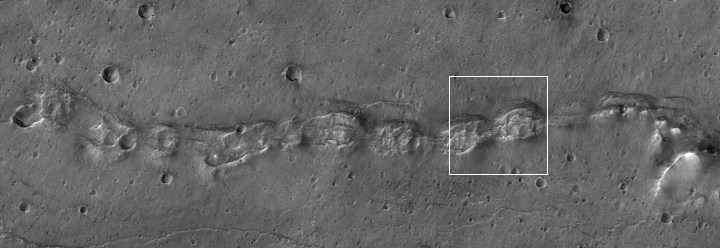A Martian snake of collapsed hills

Time to once again delve into this month’s release of high resolution images from Mars Reconnaissance Orbiter. The image above, cropped, rotated, and reduced in resolution to post here, shows a string of strange mounds or hills, each with similar collapse features on their tops. If you click on the picture, you can see the full resolution image, rotated properly with north up. You can also go to the MRO post, which provides some additional information.
The white box indicates the location of the cropped close-up, at full resolution, to the right. This area is typical across the entire snake-like ridge. You have these mounds or hills, each with chaotic depressions at their tops. The depressions suggest that this ridge follows an underground void, like a lava tube. The ridge-like nature of the line of hills also suggest that this tube has been exposed by erosion over time, with the surrounding terrain more easily blown or washed away while the more resistant ridge remains.
At the same time, the line of hills is baffling. Why would a lava tube expand periodically to form something that looks like a string of pearls?
The location of this snaking ridge provides some additional context.

The image to the right is taken from the full archive webpage for MRO’s high resolution camera, with the black cross the location of the snake of hills. It shows that this geological feature sits in the vast northern plains of Mars, in the outlet region of the gigantic canyon Valles Marineris. Since this canyon was first photographed by Mariner 9 in 1971, scientists have wondered if it was caused by huge liquid water flowing catastrophically out into those northern plains. This might be so, but it is also possible that lava formed some of these features, including the snake of hills in today’s highlighted image.
I really don’t know, and I suspect that any theories put forth by planetary geologists will require a healthy dose of skepticism on everyone’s part. We need to go there to really find out.
Hopefully, we shall do so, in the lifetime of the youngest person reading this webpage.
On Christmas Eve 1968 three Americans became the first humans to visit another world. What they did to celebrate was unexpected and profound, and will be remembered throughout all human history. Genesis: the Story of Apollo 8, Robert Zimmerman's classic history of humanity's first journey to another world, tells that story, and it is now available as both an ebook and an audiobook, both with a foreword by Valerie Anders and a new introduction by Robert Zimmerman.
The print edition can be purchased at Amazon or from any other book seller. If you want an autographed copy the price is $60 for the hardback and $45 for the paperback, plus $8 shipping for each. Go here for purchasing details. The ebook is available everywhere for $5.99 (before discount) at amazon, or direct from my ebook publisher, ebookit. If you buy it from ebookit you don't support the big tech companies and the author gets a bigger cut much sooner.
The audiobook is also available at all these vendors, and is also free with a 30-day trial membership to Audible.
"Not simply about one mission, [Genesis] is also the history of America's quest for the moon... Zimmerman has done a masterful job of tying disparate events together into a solid account of one of America's greatest human triumphs."--San Antonio Express-News



Sand Worm sign.
John: Heh.
I have a question while I am looking at these many mostly un eroded surfaces:
Q: Is there a possibility on any particular planet or moon in our solar system where an atmosphere could somehow be developed and captured to it?
Cotour: You ask a very complicated and difficult question. We probably do not have enough information to really answer it. However, except for Venus, there is no other rocky planet (or moon) in the solar system comparable in mass to the Earth. All other rocky planets are smaller, and except for Titan, do not have significant atmospheres.
Titan suggests that some of the larger examples of these smaller rocky planets could hold an atmosphere, but I suspect not. Titan is very far from the Sun, which probably helps it hold onto its atmosphere. That coldness however makes it unlivable for humans. And if you warmed it up it likely could no longer hold its atmosphere.
The solution in this solar system I think will always be enclosed habitats, sometimes underground.
The picture of the snake mounds on Mars is another good catch, what odd geography. There are parallel canyons to either side indicating that this whole region has sunk down.
I think you may have found a collapsed water table probably fed by artesian pressure from the higher plateau. As water comes to the surface, it would boil away in the low air pressure, leaving the sharp, angler, white minerals behind.
Once the mineral buildup got too heavy on the surface, it would collapse down on the subterranean cavern causing the water to back up and start the process all over again upstream.
This is just conjecture mixed with fantasy of course. If there was water flowing from a artesian well we would see erosion near the mounds with dry lakes full of mineral deposits.
Cotour,
In theory, Mars could hold a atmosphere made of a heavier substance like Freon. This would allow out door movement without a space suit. More air pressure will hold heat/generate heat so you would only need a breathing apparatus outside.
Generating enough heavy gases to cover a planet is impossible of course. It would also have the unintended consequence of pushing all of the natural atmosphere of CO2 into space. After a few centuries, UV light would break down the Freon giving Mars a poisonous atmosphere. Best not to fool with mother nature.
Venus, Saturn, Uranus, and Neptune are all about the right size for terraforming for human habitation. It would take centuries if not thousands of years to convert their thick, hot atmospheres into water and minerals.
In the end, Z man has the right of it. The only place humans can live in the open is here on earth. (come to think of it, no one on earth actually lives in the open either)
Been to a few lectures about mega floods on Mars and the geologists never get into why they happened, only that they did.
I have a suggestion for how a winding lava tube might form hills that eventually collapse. Essentially, think “super-sized hornitos”. Here on Earth, a hornito is formed when a lava flow in a tube is under such pressure from above that lava pushed up through a crack to the surface, and eroded the crack open enough to continue the flow to the point where a pointy mound with a possibly open top is formed as a “mini-volcano”. I have never seen one bigger than 3 meters tall, though I am told they get as big as 10 meters here on Earth.
On Mars, with lower gravity, but higher possible pressure inside a lava tune, from greater height at a vent in someplace like Mons Olympus, I can at least imagine a hill-sized hornito forming. I have no calculations to offer on the subject, however. The truly interesting part is *multiple* hornitos forming, and then collapsing along a single stretch of lava tube!
I suppose that *if* a *secondary* flow of lava through an established lava tube were very hot, and *if* the tube roof was particularly thin but not thin enough to break into an open collapse trench, then you could get multiple large hornitos forming with hollows inside and under them, from which later erosion might cause multiples collapses, such as we see here. Lotsa “if”s in that, though.
@Cotour
The gas giants captured their atmospheres from the Solar nebula during their formation. Almost everything is hydrogen and helium that gravitationally catches on to the first large rick/ice body formed by colliding dust grains. Most exoplanet have extremely low density, probably because they have huge hydrogen atmospheres.
But smaller and later formed objects (like the moons) don’t “capture” an atmosphere. They outgas it with volcanism or tidal forces or tectonics or by whatever mechanism. Titan of Saturn is losing its atmosphere, but is replenishing it from the underground. Triton of Neptune is obviously captured and outgasses, but not fast enough to uphold an atmosphere. At least not now.
When the modeled formation of the Moon occurred, Earth had an atmosphere of gaseous silicon and stuff like like that. It then settled as rocks, Then volcanoes and biology created the current atmosphere. A shift has happened from believing that most water came from comet impacts, to the realization that most of Earth’s water today was preserved here even as the entire planet was molten. The difference in hydrogen isotopes here and elsewhere kind of reveals that.